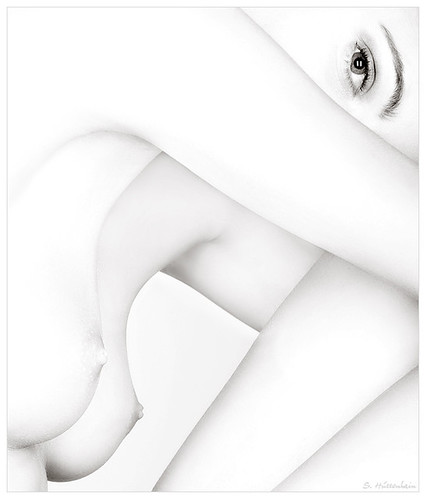I had to use a bit of artistic licence to create a pose that would capture elements of the photo but remain printable on my 3D printer.
Here is the digital version of the pose that I wanted to try and print.
 |
Capturing the Sascha Hüttenhain pose |
 |
Viewed from the other side |
Hair is a real problem when using the models in 3D posing software. It usually consists of multiple flat layers combined to give the illusion of depth. This may work for 2D images, but 3D printing demands real depth with solid models and the standard hair add-ons don't work.
One of the most useful techniques I have tried, is to export a hair style as an .OBJ file, import it into Blender and then use the Shrinkwrap modifier on it. It isn't a completely automatic process yet, because it still needs a fair degree of tweaking, but it is much better than attempting to print the original hair model. The finished hair object can be combined with the rest of the body with a Boolean Union join to create a single watertight mesh which the slicing software can cope with.
This model presents several new challenges. The head is tilted sideways; the legs are at a shallower angle; the left elbow is beside the knee, not resting on it; the hands are being held horizontally, one above the other.
All of these factors led me to the conclusion that I would have to turn on automatic support in my slicing software. I would also have to print with ABS plastic because of the way that the support elements will have to break away from the model, leaving the minimum of scarring. I fully expect to have to do some post-processing work after printing this model.
I generally use Slic3r for turning my 3D models into printer instructions, but I don't find it that good at generating support material. Recently, I have had more success with using Kisslicer when I need good support material. Printing models with a small footprint, and this includes support material, is sometimes more reliable if it is laid down on a printed raft, rather than directly onto the printer bed.
In Kisslicer, I turned on the Raft option and set the Support material density to medium.
I set the model height to 8 cm and the layer height to 0.2 mm, giving a total of 400 discrete layers.
Here is a close-up preview of the printer file rendered by the excellent printer controller software, Repetier-Host, showing the raft (under the feet), the support structures (under the legs) and the individual layers of the model.
 |
Repetier-Host preview render |
Printed in grey ABS at 240°C, 0.2 mm layer height, waiting for support material to be removed.
And now, following removal of the support material and surface blemishes.
Removing the support material
Video





